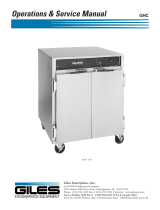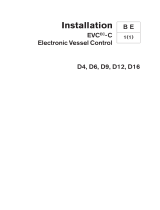
12 GHP 10V Installation Instructions
1. Drive the boat in one direction with the autopilot engaged (heading
hold).
The boat should not oscillate signicantly; however, a small amount
of oscillation is normal.
2. Turn the boat in one direction using the autopilot and observe the
behavior.
The boat should turn smoothly, not too quickly or too slowly.
When you turn the boat using the autopilot, the boat should
approach and settle on the desired heading with minimal overshoot
and oscillation.
3. Select an option:
• If the boat turns too quickly or too sluggishly, adjust the
autopilot acceleration limiter (page 12).
• If the heading hold oscillates signicantly or the boat does not
correct when turning, adjust the autopilot gain (page 12).
• If the boat turns smoothly, the heading hold oscillates only
slightly or not at all, and the boat adjusts the heading correctly,
proceed to step 5.
4. Repeat steps 2 and 3 until the boat turns smoothly the heading hold
oscillates only slightly or not at all, and the boat adjusts the heading
correctly.
5. For planing vessels, repeat steps 1–4 at faster speeds (page 12).
NOTE: When you manually adjust the acceleration limiter, make
relatively small adjustments. Test the change before making additional
adjustments.
1. Turn on the GHP 10V using the advanced conguration procedure
(page 12).
2. On the GHC 20V, select Menu > Setup > Dealer Autopilot
Conguration > Autopilot Tuning > Acceleration Limiter.
3. Select an option:
• Increase the setting if the autopilot turns too quickly,
• Decrease the setting if the autopilot turns too slowly.
4. Test the autopilot conguration.
5. Repeat steps 2 and 3 until the GHP 10V performance is satisfactory.
NOTE: When you manually adjust the rudder gain (or counter gain),
make relatively small adjustments, and adjust only one value at a time.
Test the change before making additional adjustments.
1. Enable the advanced conguration procedure (page 12).
2. On the GHC 20, select Menu > Setup > Dealer Autopilot
Conguration > Autopilot Tuning > Rudder Gains.
3. Select an option:
• Select Low Speed or High Speed and use the arrows on the
GHC 20 to adjust how tightly the rudder holds the heading and
makes turns at low speed or high speed.
If you set this value too high, the autopilot may be overactive,
attempting to constantly adjust the heading at the slightest
deviation. An overactive autopilot can cause excess wear and
tear on the drive unit, and drains the battery at a faster-than-
normal rate.
• Select Low Speed Counter or High Speed Counter to adjust
how tightly the rudder corrects the turn overshoot. If you set this
value too high, the autopilot can overshoot the turn again when
attempting to counter the original turn.
4. Test the autopilot conguration.
5. Repeat steps 2 and 3 until the GHP 10V performance is satisfactory.
Advanced conguration options are not available on the GHC 20 under
normal conditions. To access the advanced conguration settings of the
GHP 10V, enable the advanced conguration procedure.
1. From the heading screen, select Menu > Setup > System > System
Information.
2. Press and hold the center soft key
➊
for 5 seconds.
Dealer Mode appears.
➊
3. Press Back > Back.
If the option for Dealer Autopilot Conguration is available on the
Setup screen, the advanced conguration procedure is enabled.
You can run the Autotune automated conguration process, calibrate
the compass, and dene north on the GHP 10V through the GHC 20
without running the wizards. You can also dene most settings
individually, without running the conguration processes.
1. Enable the advanced conguration procedure (page 12).
2. From the Heading screen, select Menu > Setup > Dealer Autopilot
Conguration > Automated Setup.
3. Select Autotune, Calibrate Compass, or Set North.
4. Follow the on-screen instructions.
The Sea Trial Wizard allows you to quickly dene all of the important
conguration settings on the GHP 10V. After running the wizard, if
you do not feel the GHP 10V is working correctly, you can run the
wizard again at any time. To access the wizard, enable the advanced
conguration procedure (page 12).
1. Enable the advanced conguration procedure (page 12).
2. From the Heading screen, select Menu > Setup > Dealer Autopilot
Conguration.
3. Select the a setting category.
4. Select a setting to congure.
Descriptions of each setting are available in the appendix (page 15).
5. Congure the value of the setting.
NOTE: Conguring certain settings in the dealer autopilot
conguration procedure may require you to modify other settings.
Review the GHP 10V Congurations Settings section (page 15) prior to
modifying any settings.






















